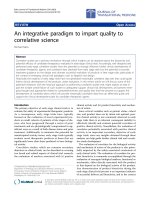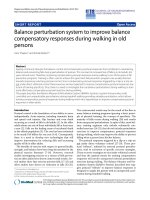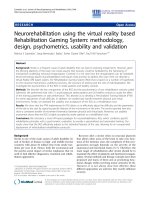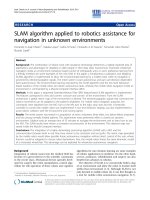Báo cáo hóa học: " Editorial Mobile Multi-Hop Ad Hoc Networks: From Theory to Reality" ppt
Bạn đang xem bản rút gọn của tài liệu. Xem và tải ngay bản đầy đủ của tài liệu tại đây (423.66 KB, 2 trang )
Hindawi Publishing Corporation
EURASIP Journal on Wireless Communications and Networking
Volume 2007, Article ID 60740, 2 pages
doi:10.1155/2007/60740
Editorial
Mobile Multi-Hop Ad Hoc Networks: From Theory to Reality
Marco Conti
Consiglio Nazionale delle Ricerche (CNR), Istituto di Informatica e Telematica (IIT), Via Giuseppe, Moruzzi 1, 56124 Pisa, Italy
Received 14 February 2007; Accepted 14 February 2007
Copyright © 2007 Marco Conti. This is an open access article distributed under the Creative Commons Attribution License, which
permits unrestricted use, distribution, and reproduction in any medium, provided the original work is properly cited.
It is a great pleasure to introduce this special issue. Multi-
hop ad hoc networks are collections of (mobile) nodes con-
nected together over a wireless medium. These nodes can
freely and dynamically self-organize into arbitrary and tem-
porary, “ad hoc” network topologies. A mobile ad hoc net-
work (MANET) is probably the most well-known exam-
ple of this networking paradigm having been around for
over twenty years, mainly exploited to design tactical net-
works. Recently, emerging wireless networking technologies
for consumer electronics (e.g., Bluetooth and IEEE 802.11)
are pushing MANET outside the military domain and also
contributed to the MANET evolution towards mesh and op-
portunistic networks. Furthermore, the multi-hop ad hoc
networking paradigm is often used for building sensor net-
works to study, control, and monitor events and phenomena.
Multi-hop ad hoc networking technologies have big po-
tentialities for innovative applications of great impact on
our everyday life. To exploit these potentialities, simulation
modeling and theoretical analyses have to be complemented
by real experiences (e.g., experiences/measurements on real
prototypes), which provide both a direct evaluation of ad hoc
networks and, at the same time, precious information for a
realistic modeling of these systems. The availability of pro-
totypes will also make possible to start creating communities
of users that, by experimenting with ad hoc networking tech-
nologies, will provide feedbacks on its usefulness and stimu-
late the development of applications tailored for the ad hoc
environment.
The aim of this special issue is to present a collection of
papers that contribute to move mobile ad hoc networking
from theory to reality by presenting application scenarios for
these networks and/or results from real ad hoc networks test-
beds and prototypes. In response to an open call for papers,
we received thirty-six submissions out of which, after an in-
depth review process, we finally selected the eleven papers
presented in this issue.
The first three papers in this special issue present a set of
results on design, implementation, and experimental evalu-
ation of mobile ad hoc networks achieved in the framework
of the MobileMAN project funded by the European Com-
mission under the FET-IST Programme. The MobileMAN
project combined theoretical studies with experiences gained
by implementing real ad hoc networks, and therefore it rep-
resents a relevant step in moving MANETs from theory to
reality. The three MobileMAN papers presented in this issue
address three different aspects of a MANET protocol stack:
medium access control (MAC) protocol, routing protocols,
and application-layer multicasting.
Specifically, in the first paper of this issue “Design
and implementation of an enhanced 802.11 MAC architec-
ture for single-hop wireless networks,” Ralph Bernasconi et
al. present a testbed implementation of mechanisms that
have been defined in previous works in the important field
of IEEE 802.11 MAC optimization. Experimental results con-
firm the theoretical analyses.
In the next paper, “Effects of unstable links on AODV
performance in real testbeds,” Eleonora Borgia and Franca
Delmastro present an exper imental study to investigate the
impact of unidirectional/unstable links on the behavior of
two well-known routing protocols for ad hoc networks:
OLSR and AODV. The presented results are relevant because
the impact of unidirectional links is generally neglected in
simulation studies of the routing protocols, where symmetric
links conditions are generally assumed. On the other hand,
the authors, by performing measurements on a real testbed,
point out the poor behavior of AOVD with unstable links,
and explain the reasons for this behavior. Furthermore they
show that, in the same conditions, OLSR is typically more
stable.
Following this, Andrea Passarella and Franca Delmastro
in their paper “Usability of legacy p2p multicast in multi-
hop a d hoc networks: an exper imental study” evaluate p2p
2 EURASIP Journal on Wireless Communications and Networking
multicast solutions in mobile ad hoc networks. Specifically,
the authors investigate how Scribe (a solution based on
Pastry) performs in MANET environments. First, the au-
thors contrast the performance of Scribe when running over
proactive and reactive routing protocols. Then, they compare
different versions of Pastry, showing that Pastry 1.4 generally
decreases the packet loss rate and the average delivery delay,
thus highly improving the usability of the target application.
MANET is the topic also of the next three papers of the
issue. In the first paper, “TCP-friendly bandwidth sharing in
mobile ad hoc networks: from theory to reality,” Evgeny Os-
ipov and Christian Tschudin study the unfairness between
multiple TCP flows in wireless multi-hop networks. Specif-
ically, the authors adapt to this problem the max-min fair-
ness model, and present an algorithm for load distribution
between TCP connections that guarantees the max-min fair-
ness between multiple flows. Finally, the authors propose a
rate throttling mechanism to enforce the fairness.
Modeling users’ mobility in multi-hop a d hoc networks
is the subject of the paper “A Markovian model representa-
tion of individual mobility scenarios in ad hoc networks and
its evaluation” by Carlos Alberto Campos and Luis Felipe
Moraes. Specifically, the authors investigate how to provide
a realistic model describing nodes’ mobility in ad hoc net-
works. To better characterize the mobile nodes movement,
the authors propose to use Markov models. By exploiting the
Markovian random path model, they develop a model that is
more suitable to take into account the real-life mobility fea-
tures than, for example, the random waypoint model. The
analysis of mobility models’ impac t on routing protocols per-
formance completes the paper.
Next, Miguel Almeida et al. in “Experimental evaluation
on the usage of ad hoc networks as stubs for multiservice net-
works” study the performance of an ad hoc network when
used as a wireless extension of the Internet. In the paper the
authors present an experimental study of this scenario by in-
vestigating the performance of services like unicast and mul-
ticast routing, legacy multimedia, and security that would be
interesting to have on this type of networks.
Using multi-hop ad hoc networks as an Internet exten-
sion is the main objective of mesh networks, which are ana-
lyzed, in the following two papers. In the first paper, “Eval-
uation of cross-layer rate-aware routing in a wireless mesh
network test-bed,” Luigi Iannone et al. present the perfor-
mance evaluation, in a wireless-mesh-network testbed, of a
routing protocol that exploits a cross-layer rate metric for
identifying the best routes. The authors show that the ap-
proach with cross-layer information can improve the stabil-
ity and throughput of the routes. Furthermore, experiments
with TCP-flows show marked improvements in terms of de-
liver y rate compared to routes built using the minimum-hop
metric.
In the next paper, “Wireless mesh networks to support
video-surveillance: architecture, protocol and implementa-
tion issues,” Francesco Licandro and Giovanni Schembra re-
port practical exper iences gathered during the implementa-
tion and operation of a large-scale video-surveillance sys-
tem in which they use wireless mesh networks to intercon-
nect the video cameras with the monitoring servers. Prelim-
inary experimental results advocate that multipath routing
algorithms can provide much higher performance than tra-
ditional single-path routing based on the shortest paths.
The last set of papers of this special issue deal with sensor
networks. This is a special case of multi-hop ad hoc networks.
Indeed the aim of a sensor network is to collect information
about events occurring in the sensor field, rather than sup-
porting the communications between nodes. This, coupled
with the constraints of the sensor devices, requires solutions
tuned on sensor networks characteristics.
In “Wireless sensor networks: performance analysis in in-
door scenarios,” Gianluigi Ferrari et al. analyze the perfor-
mance of two wireless sensor networks technologies, Zig-
Bee and Z-Wave, in indoor scenarios. Single and multi-
hop topologies are experimentally characterized by means
of RSSI, throughput, and end-to-end delay. In addition, an-
alytical and simulation results are provided to validate the
ZigBee-related experiments.
The management of the software-configuration in wire-
less sensor networks is the topic of the next paper “Profile-
matching techniques for on-demand software management
in sensor networks” by Falko Dressler et al. This is becoming
a prominent challenge due to the heterogeneity and dynam-
ics of hardware and software configurations. To tackle this
problem, the authors have developed a profile-based software
management scheme that consists of an algorithm to iden-
tify current hardware and software configurations, an on-
demand code generation module, and mechanisms for dy-
namic network-centric reprogramming of sensor nodes.
In the last paper of this issue, “Optimal and approxi-
mate approaches for deployment of heterogeneous sensing
devices,” Rabie Ramadan et al. apply multiple sets of het-
erogeneous sensors for large-scale surveillance operations.
Specifically, the authors propose a modeling framework for
the problem of deploying a set of heterogeneous sensors in a
field w ith time-varying surveillance requirements. The prob-
lem is formulated as mixed integer mathematical program
with the objective of maximizing the coverage of a given
field. To solve the problem the authors have proposed two
heuristic-based on genetic algorithm and simulated anneal-
ing.
ACKNOWLEDGMENT
As a Guest Editor it has been a great pleasure to put to-
gether this issue. I would like to thank the authors for their
contributions and the reviewers for their time, energy, and
comments that helped shape this special issue.
Marco Conti









